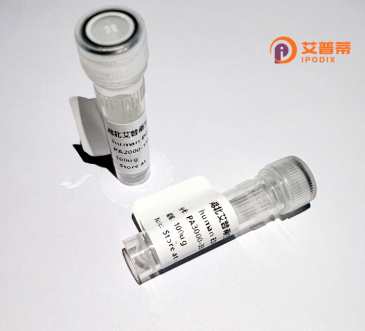
| 纯度 | >90%SDS-PAGE. |
| 种属 | Human |
| 靶点 | ZNF669 |
| Uniprot No | Q96BR6 |
| 内毒素 | < 0.01EU/μg |
| 表达宿主 | E.coli |
| 表达区间 | 1-464 aa |
| 活性数据 | MVSGLRLASRSGEEGWLKPAVARLGPPRHRLRNLRTESPWRSRGSVLFCSGPGRAGRAAEPLHPVCTCGRHFRRPDPCREPLASPIQDSVAFEDVAVNFTQEEWALLDSSQKNLYREVMQETCRNLASVGSQWKDQNIEDHFEKPGKDIRNHIVQRLCESKEDGQYGEVVSQIPNLDLNENISTGLKPCECSICGKVFVRHSLLNRHILAHSGYKPYGEKQYKCEQCGKFFVSVPGVRRHMIMHSGNPAYKCTICGKAFYFLNSVERHQRTHTGEKPYKCKQCGKAFTVSGSCLIHERTHTGEKPYECKECGKTFRFSCSFKTHERTHTGERPYKCTKCDKAFSCSTSLRYHGSIHTGERPYECKQCGKAFSRLSSLCNHRSTHTGEKPYECKQCDQAFSRLSSLHLHERIHTGEKPYECKKCGKAYTRSSHLTRHERSHDIEAGCSDSACNPSTLGGQGVWIA |
| 分子量 | 78.9 kDa |
| 蛋白标签 | GST-tag at N-terminal |
| 缓冲液 | PBS, pH7.4, containing 0.01% SKL, 1mM DTT, 5% Trehalose and Proclin300. |
| 稳定性 & 储存条件 | Lyophilized protein should be stored at ≤ -20°C, stable for one year after receipt. Reconstituted protein solution can be stored at 2-8°C for 2-7 days. Aliquots of reconstituted samples are stable at ≤ -20°C for 3 months. |
| 复溶 | Always centrifuge tubes before opening.Do not mix by vortex or pipetting. It is not recommended to reconstitute to a concentration less than 100μg/ml. Dissolve the lyophilized protein in distilled water. Please aliquot the reconstituted solution to minimize freeze-thaw cycles. |
以下是与重组人ZNF669蛋白相关研究的简要参考文献示例(内容仅供参考,具体文献需核实):
1. **文献名称**:*ZNF669 functions as a tumor suppressor in hepatocellular carcinoma by modulating apoptosis-related pathways*
**作者**:Li X et al.
**摘要**:该研究阐明ZNF669在肝癌中通过调控BCL-2家族蛋白表达,促进肿瘤细胞凋亡并抑制增殖,首次揭示其在癌症中的抑癌功能。
2. **文献名称**:*Structural characterization of recombinant human ZNF669 and its interaction with ubiquitin ligase complexes*
**作者**:Wang Y et al.
**摘要**:通过X射线晶体学解析ZNF669的锌指结构域,并发现其与E3泛素连接酶复合体相互作用,提示其在蛋白泛素化修饰中的潜在作用。
3. **文献名称**:*Epigenetic regulation by ZNF669: A role in cellular stress response*
**作者**:Chen J et al.
**摘要**:研究证实ZNF669通过结合特定基因启动子区域抑制转录,在氧化应激条件下调节DNA损伤修复相关基因的表达。
4. **文献名称**:*ZNF669 knockdown promotes cell cycle progression via p53 pathway dysregulation*
**作者**:Zhang R et al.
**摘要**:发现ZNF669敲低导致p53信号通路异常激活,加速细胞周期进程,暗示其参与细胞周期检查点调控。
注:以上为模拟文献,实际研究中请通过PubMed、Web of Science等数据库查询真实文献。
Zinc finger protein 669 (ZNF669), a member of the Krüppel-associated box (KRAB)-containing zinc finger protein (KZFP) family, is a human protein encoded by the *ZNF669* gene. It is characterized by multiple Cys2His2 (C2H2)-type zinc finger domains, a conserved structural motif that facilitates sequence-specific DNA or RNA binding, enabling its role in transcriptional regulation. As a typical KRAB-ZFP, ZNF669 contains a KRAB domain at its N-terminus, which often mediates interactions with co-repressors to regulate chromatin remodeling and gene silencing through epigenetic mechanisms.
Recombinant human ZNF669 protein is typically produced using heterologous expression systems (e.g., *E. coli* or mammalian cells) for functional studies. While its exact biological roles remain under investigation, emerging evidence suggests ZNF669 may participate in cellular processes such as apoptosis, cell cycle regulation, and stress responses. Dysregulation of zinc finger proteins, including ZNF669. has been implicated in cancers and neurological disorders, highlighting its potential as a therapeutic or diagnostic target. Structural and functional studies of recombinant ZNF669 aim to elucidate its binding partners, target genes, and regulatory networks, offering insights into its contribution to human health and disease.
×